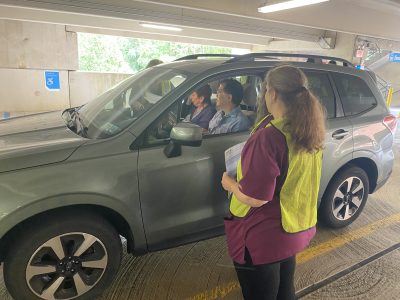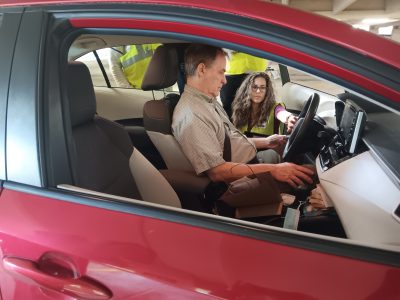Phelps Event Helps Older Drivers Stay Safe on the Road
News Based on facts, either observed and verified directly by the reporter, or reported and verified from knowledgeable sources.

Making sure all of the safety features on a car work well and the driver has their lights, seat, steering wheel and mirrors in proper position is critical at any age.
For older adults who are still driving, making sure they are properly situated in their vehicle and having everything in good working order is critical to making sure they are as well protected as possible.
Phelps Hospital recently hosted event called CarFit, an educational program where occupational therapists from the hospital run through a roughly 20-minute checklist in the facility’s garage to help older drivers maximize the features of their car. The program was created by AAA, AARP and the American Occupational Therapy Association.
“These were kind of educational events that were free to the public to help educate senior drivers about the safety features of the vehicle, so in the event of any kind of crash these safety features are there to help protect them,” said Kathleen Golisz, a longtime occupational therapist and professor emeriti at Mercy College, who worked with some of the drivers at the event on Sept. 28.
When going through the checklist, the therapists raised little-known or forgotten points that could help almost any driver of any age who wants to learn about how to maximize safety while operating their car.
For example, a paper ruler was used to make sure there was at least 10 inches between the steering wheel and the driver’s chest and that the center of the wheel is angled so it is pointing at the torso and not at the person’s face. That is important because the steering wheel contains the airbag, and if there is deployment, it can cushion any blow to the torso and not the face.
In the days before airbags, drivers were taught to keep their hands on the wheel in the 10 a.m./2 p.m. position. But today, that would prevent the airbag from doing the job its designed to do. Therefore, it is recommended that drivers position their hands more like an airplane pilot at 8 a.m./4 p.m.

Making sure the driver’s seat is at the proper level so the motorist can see over the top of the steering wheel is necessary, while positioning the sideview mirrors so that you can almost entirely eliminate the blind spot is another crucial piece of information that was shared.
The OTs, also made sure drivers had properly functioning turn signals, headlights (including high beams) and tail lights and knew how to activate the emergency break, if needed.
It was demonstrated where the seat belt and shoulder harness should be situated, making sure that the shoulder belt has no chance of digging into a person’s neck, which could cause injury, especially in an accident.
Another recommendation is for drivers to adjust their headrest so their ears are about in the middle of the headrest.
The recent CarFit at Phelps was the first time it was held since 2019. It was discontinued due to the pandemic, and only recently was it restarted. Amy Harper, the supervisor on site from Phelps at CarFit, said the plan is to continue having the event at least on an annual basis

Martin has more than 30 years experience covering local news in Westchester and Putnam counties, including a frequent focus on zoning and planning issues. He has been editor-in-chief of The Examiner since its inception in 2007. Read more from Martin’s editor-author bio here. Read Martin’s archived work here: https://www.theexaminernews.com/author/martin-wilbur2007/
